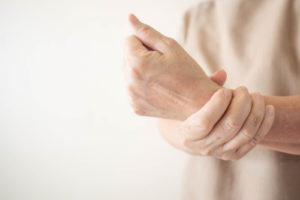
Arthritis occurs when inflammation strikes our joints, causing stiffness, swelling, pain, and dysfunction. There are multiple types of arthritis with different causes and different treatments, but the symptoms are all similar.
While the most common type of arthritis, osteoarthritis, usually affects older people, arthritis can affect anyone, at any age.
The key elements of what causes arthritis are a mixture of genetics, lifestyle factors and environmental exposures. Some arthritis risk factors can’t be controlled, but many can.
Arthritis Risk Factors You Can’t Control
There are several risk factors for what causes arthritis that are outside of your control.
Age
Your risk of arthritis goes up as you age. Osteoarthritis (OA), which occurs as a result of injury overuse, and wear-and-tear on joints often starts after age 45.
Genetics and Inherited Traits
While there are many different forms of arthritis, many of them have a genetic basis. If you have a close relative with osteoarthritis, you’re more likely to have it yourself. Various biomechanical problems, such as having one leg shorter than the other or having a hip joint set at a wide angle, also make osteoarthritis more likely.
Free Report: 20 Simple Ways To Make Your Lifestyle More ActiveRheumatoid arthritis also has a genetic component. People with a set of genes called human leukocyte antigen (HLA) class II genotypes are more likely to have rheumatoid arthritis, systemic lupus erythematosus and ankylosing spondylitis.
Gender
Women are more likely to have most types of arthritis, including osteoarthritis, rheumatoid arthritis and fibromyalgia. Men are more likely to have gout.
Arthritis Risk Factors You Can Control
While no one can change what causes arthritis because of their genetics or their age, you can control many of the risk factors of arthritis.
Overweight and Obesity
People who are overweight or obese are more likely to get knee osteoarthritis than people who are not overweight. Being overweight puts excess stress on joints and can make existing arthritis worse. Being overweight also raises the risk of diabetes, which is a risk factor for rheumatoid arthritis.
To help manage your weight, eat a diet rich in fruits, vegetables, legumes, whole grains, lean protein and healthy fat from fatty fish, olive oil, nuts and seeds. Stay active and aim for at least 30 minutes of brisk movement per day.
Infection
Some bacteria and viruses can infect joints, leading to arthritis and joint damage. If your joints are swollen, red and warm, see your doctor right away.
Joint injuries
While accidents do happen, you can help prevent many joint injuries by maintaining your strength and flexibility. Knees are particularly vulnerable, especially if you play soccer, football, rugby, or other contact sports. The Osteoarthritis Action Alliance has a series of knee-strengthening exercises that can anyone can do to help prevent injury. If you do injure a joint, see your doctor right away. Proper treatment can help prevent soreness down the road.
Repetitive Stress Injuries
Performing the same motion again and again over hours, days, weeks, and months can lead to joint injury and arthritis. If you must perform repetitive motions at work, make sure your workspace and tools are fitted to your physical abilities and limitations. The National Institute for Occupational Safety and Health (NIOSH) has more information about ergonomics and the workplace.
Smoking
Smoking tobacco increases your risk of rheumatoid arthritis and can make arthritis worse. If you smoke, quit.
20 Ways To Restore Mobility, Strength and Flexibility
When you are sore and aching, exercise might be the last thing you think of, but research increasingly shows that it should be the first. Of course, if you have arthritic joints, the type of exercise you do is extremely important. Gentle movement helps restore and maintain mobility, strength, and flexibility, and can help soothe pain.
Low-impact exercise is one of the best things you can do for your joints and your overall health. If you can’t yet do much, start with just five minutes a day of whatever movement you most enjoy, and work your way up. To help you get started download my free report 20 Ways To Make Your Lifestyle More Active.

